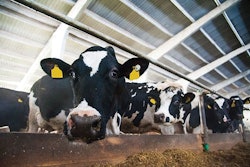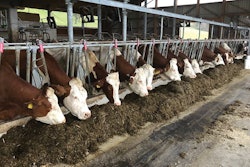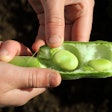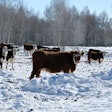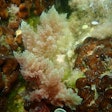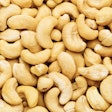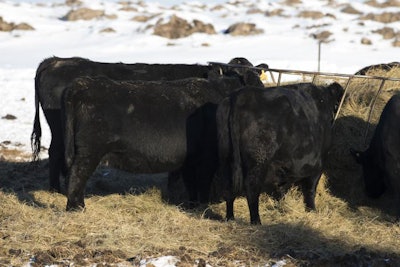
Nutrition is not only important in assuring a pregnant cow's health, but it also has a huge impact on the calf’s well-being. With many cattle producers in the Midwest in the midst of heavy calving, it is important to keep significant nutritional influences in mind.
Daniel Shike, associate professor in the Department of Animal Science at the University of Illinois, has spent ample time identifying nutritional plans that improve the reproduction and longevity of beef cows, but also optimize growth, efficiency and traits of the cow’s offspring.
Shike explained some important factors in managing cattle nutrition pre- and post-calving.
1. Meeting energy requirements is key
A cow’s nutritional requirements are the lowest after she weans a calf and is in mid-gestation. However, producers should still be sure they are meeting her energy and protein requirements.
“Average to low-quality hay often meets the energy and protein requirements,” Shike said.
As calving time approaches, the energy requirements increase as the majority of fetal growth occurs in the last trimester, he said.
“A quality vitamin/mineral supplement should be offered free choice or included in the total mixed ration (TMR). Injectable trace minerals are a good option as well. They ensure every cow gets the right amount at the right time,” he said.
2. Body condition score is important
Cows should ideally calve with a body condition score of five to six. Shike added that, although nutritional requirements are greater during late gestation, nutrition is also important in in early or mid-gestation.
3. Energy requirements change post-calving
“The energy and protein requirements of the cow go up significantly post calving,” Shike said.
Producers do not want their cows to be in a negative energy balance for very long leading up to breeding time.
“You will need to feed your highest-quality hay and consider supplementing additional energy and protein depending on the quality. You should always have your forage tested so you know what supplementation strategies should be considered,” he said.
4. Maintaining cost efficiency
It is crucial to achieve cost efficiency while maintaining good body condition score.
Hay price and availability varies greatly from region to region due to weather conditions in the growing season.
“For many producers in the Midwest, the least-cost option will either be corn silage-based rations or crop residue and co-product such as distillers' grains. With corn prices being lower now, they do price in some situations,” said Shike.
Some cattle producers may consider letting their herd graze cornstalks. This is a very cost-effective management strategy, and one that Shike recommends.
“I recommend this being more of a fall strategy than a winter strategy, but it definitely can still be done. Distillers' grains make an excellent supplement to grazing corn stalks. They are high in energy, protein and phosphorous, which all complement stalks well,” he said.
5. Change feeding programs based on weather changes
Weather can have a great impact on nutritional requirements of cattle.
“The extent to which temperature and precipitation affect requirements depends on facilities and location of cattle,” he said. If cattle have shelter, wind blocks, and concrete to stand on, then the weather has less effect on them. Cattle require less feed in warmer temperatures.
However, depending on a producer's location they should still make different nutritional choices when cattle are in gestation.



